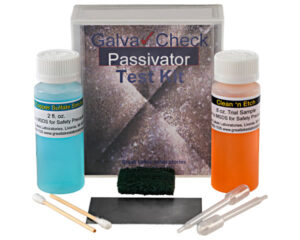Summary
This details a recommended method for prepping sheet galvanized used for ventilation ductwork, roof decking and many other applications. New galvanized steel of this type usually has a clear, glossy, “passivation” film which will cause the loss of coating adhesion if it is not removed.
The passivation film is applied by the galvanizer to prevent the zinc from reacting with water and carbon dioxide during transportation and storage.
Unprotected zinc forms white, powdery deposits of zinc oxides, hydroxides and carbonates, that are commonly referred to as “white rust”, “zinc salts” or “zinc soaps.” If white deposits on an unpassivated zinc surface are not removed prior to coating, coating failure usually occurs.
The glossy passivation film is often misidentified as a wax or an oil. It is neither and cannot be removed by solvents such as xylene. The film is a thin coating of an alkaline liquid, similar to the “cure & seal” used on concrete, which can be removed with Great Lakes Laboratories Clean ‘n Etch, an odorless, acid-based detergent.
Equipment
- Rubber Gloves, Dust Mask
- Safety goggles or face shield
- 2.5 – 3 gallon, all plastic, hand-pump, tank-type, garden sprayer
- Water for rinsing can be applied with an airless sprayer, water hose or garden sprayer.
Procedure
- Mix 1 part Clean ‘n Etch with 2 parts water.
- Mix Clean ‘n Etch in required strength using hot water, if available.
- Adjust the spray nozzle for a medium spray to reduce the aerosol effect.
- Work in sections to ensure that the surface is rinsed before the solution begins to dry.
- Wet the surface with the solution and allow 20 minutes of contact time.
- Rinse the treated section thoroughly with water.
- Air dry or force dry.
Usage Tips
- Each +18°F increase in the temperature of the solution will double the rate of reaction. Using hot water will reduce treatment time and may reduce the concentration required.
- Use oil-free compressed air or an electric leaf blower to reduce drying time.
Tests for Paint Readiness

- Use the GalvaCheck Passivator Test Kit to ensure that the surface is ready for paint.
- Scan the Qr Code below for an instruction video.
Troubleshooting
White deposits on the treated surface may occur if the concentration is too strong, the contact time is too long or the solution is not rinsed before drying begins.
These deposits are zinc phosphate resulting from the chemical reaction of Clean ‘n Etch with zinc on the surface and usually do not appear if the surface is rinsed before drying.
A light amount of zinc phosphate will not affect coating adhesion, however, it is good practice to brush off as much of the white powder as possible prior to coating application.
For Technical Assistance Call:
1-800-888-1105

